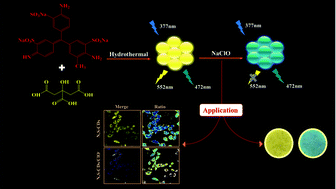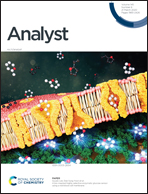Highly sensitive fluorescent carbon dots probe with ratiometric emission for the determination of ClO− †
Abstract
A ratiometric fluorescent N,S co-doped carbon dots (N,S-CDs) probe for ClO− has been facilely obtained via a one-step hydrothermal method. The N,S-CDs revealed dual emission at 478 and 552 nm with excitation at 377 nm. The intensity of the fluorescence at 478 nm remained unchanged and the fluorescence at 552 nm was quenched dramatically in the presence of ClO−. The corresponding fluctuation of color occurred from yellow to blue upon exposure to a UV lamp. Oxidation reaction of functional groups on the surface of the N,S-CDs resulted in this evident quenching. The highly ratiometric fluorescent N,S-CDs probe exhibited excellent sensitivity and selectivity towards ClO−. The quantitative analysis of ClO− showed a linear range of 0.067–60 μmol L−1 with a detection limit of 9.1 nmol L−1 (S/N = 3). Furthermore, the N,S-CDs have promising applications in paper-based fluorogenic devices for fast and easy sensing of ClO−. The ratiometric fluorescent probe could also be further used in cellular imaging, due to low toxicity, good water solubility and biocompatibility, and also has great potential in biosensing and bioimaging.



 Please wait while we load your content...
Please wait while we load your content...